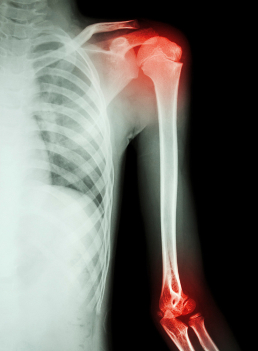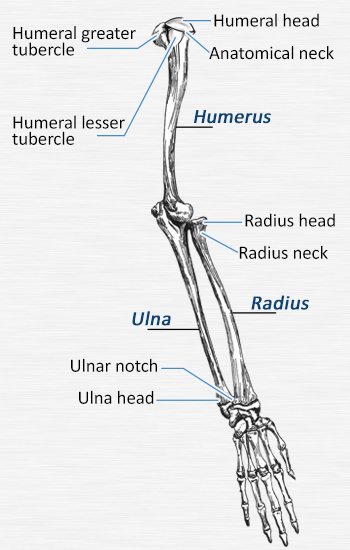In spite of its extreme flexibility, the arm consists of just three long bones. The following article will cover some information related these bones and their function...

The arms and hands are one of the most frequently used body parts. The use of our limbs comes so naturally to us that we never realize the science behind their functioning. The study of the anatomy of the human arm will give you an idea as to how complex these seemingly simple functions can be. Without the arms one would not be able to do even a simple task like eating food or holding a spoon.
Arm Bones and Muscles
The upper arm bones and muscles consist of the humerus, biceps, and triceps. The biceps are made up of two different heads and are located in the front of the arms. They help in bending the arm towards the shoulders. The triceps are present on the rear part of the upper arm and is made up of three muscles. The function of the triceps is to help the arm extend forward. The forearm bones and muscles consist of two bones and a group of several muscles, which are responsible for bending your wrist.
Anatomy
The arm consists of three bones that make up the upper arm and the lower arm. The upper arm is made up of the humerus, and the lower arm consists of the radius and the ulna.
 Humerus
Humerus
The upper arm bone that extends from the shoulder to the elbow is called the humerus. This is a long bone that helps in supporting and moving the upper arm. The humerus is divided into 3 parts, the round head, the narrow neck, and the tubercles. There are many muscles and ligaments attached to the humerus. The muscles of the humerus include the following:
- Deltoid
- Supraspinatus
- Pectoralis major
- Teres major
- Latissimus dorsi
- Infraspinatus
- Biceps brachii
- Brachialis
- Coracobrachialis
- Brachioradialis
- Triceps brachii
- Anconeus
Radius
The lower arm or forearm bone is the radius. It extends from the elbow to the wrist. The radius is long and curved in shape and runs parallel to the ulna. The function of the radius is to help in movement and supporting the arm. Muscles attached to the radius include:
- Supinator
- The flexor digitorum superficialis
- The flexor pollicis longus
- Musculus extensor ossis metacarpi pollicis
- Extensor primi internodii pollicis
- The pronator teres muscle
- Supinator longus tendons
Ulna
The last, but not the least, bone of the arm is the ulna. This bone is present between the elbow and the wrist running parallel to radius. The ulna is longer and slightly curved just like the other arm bones. The function of the ulna is also the same, to assist in support and movement of the arm. The muscles and ligaments attached to the ulna are as follows:
- Triceps brachii
- Anconeus
- Brachialis
- Pronator teres
- Flexor carpi ulnaris
- Flexor digitorum superficialis
- Flexor digitorum profundus
- Pronator quadratus
- Extensor carpi ulnaris
- Supinator
- Abductor pollicis longus
- Extensor pollicis longus
- Extensor pollicis brevis
- Extensor indicis
Pain in the arm can occur due to various reasons. Some of the common arm bone pain reasons include fracture of the bones, muscle pulls, torn ligaments and tendons, osteoarthritis, Paget's disease, peripheral neuropathy, bone cancer, etc.


 The arms and hands are one of the most frequently used body parts. The use of our limbs comes so naturally to us that we never realize the science behind their functioning. The study of the anatomy of the human arm will give you an idea as to how complex these seemingly simple functions can be. Without the arms one would not be able to do even a simple task like eating food or holding a spoon.
The arms and hands are one of the most frequently used body parts. The use of our limbs comes so naturally to us that we never realize the science behind their functioning. The study of the anatomy of the human arm will give you an idea as to how complex these seemingly simple functions can be. Without the arms one would not be able to do even a simple task like eating food or holding a spoon. 